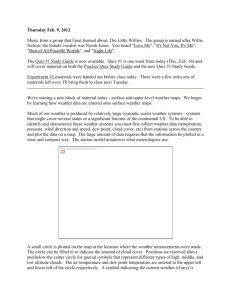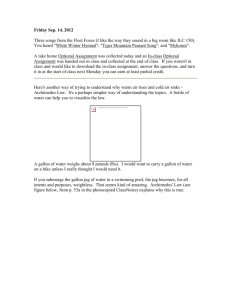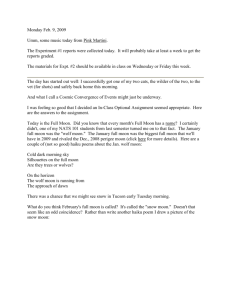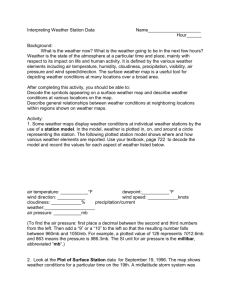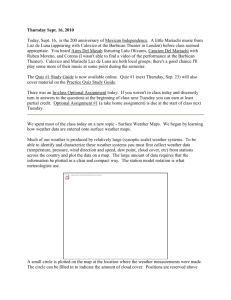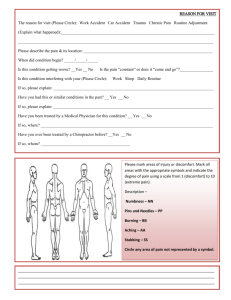feb06
advertisement
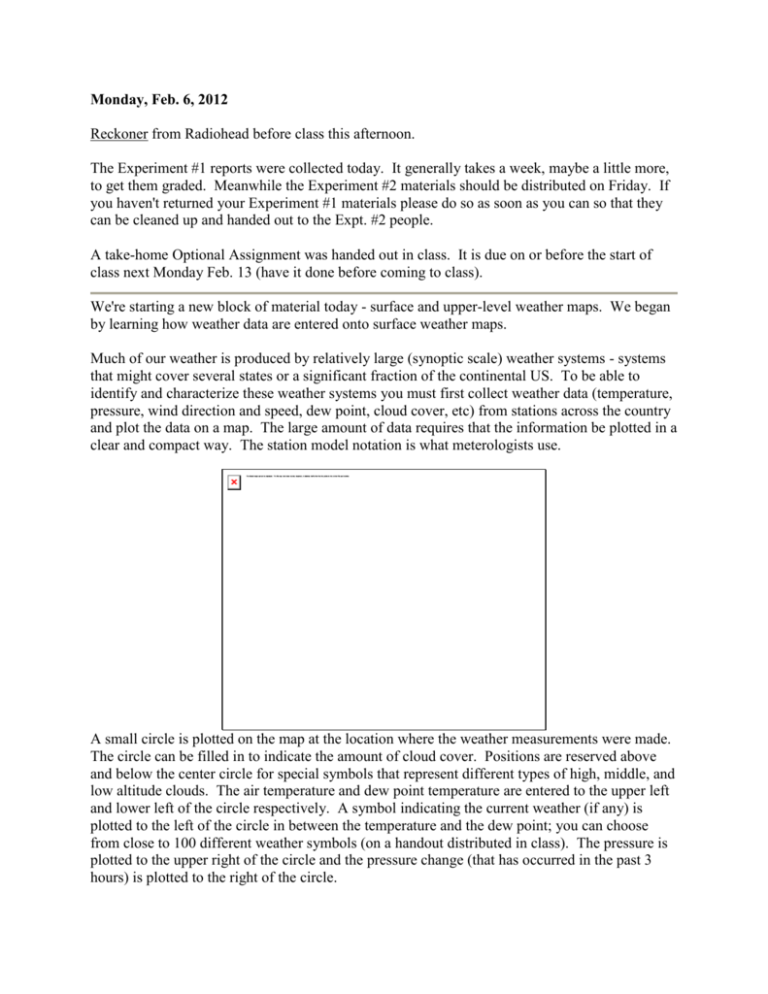
Monday, Feb. 6, 2012 Reckoner from Radiohead before class this afternoon. The Experiment #1 reports were collected today. It generally takes a week, maybe a little more, to get them graded. Meanwhile the Experiment #2 materials should be distributed on Friday. If you haven't returned your Experiment #1 materials please do so as soon as you can so that they can be cleaned up and handed out to the Expt. #2 people. A take-home Optional Assignment was handed out in class. It is due on or before the start of class next Monday Feb. 13 (have it done before coming to class). We're starting a new block of material today - surface and upper-level weather maps. We began by learning how weather data are entered onto surface weather maps. Much of our weather is produced by relatively large (synoptic scale) weather systems - systems that might cover several states or a significant fraction of the continental US. To be able to identify and characterize these weather systems you must first collect weather data (temperature, pressure, wind direction and speed, dew point, cloud cover, etc) from stations across the country and plot the data on a map. The large amount of data requires that the information be plotted in a clear and compact way. The station model notation is what meterologists use. A small circle is plotted on the map at the location where the weather measurements were made. The circle can be filled in to indicate the amount of cloud cover. Positions are reserved above and below the center circle for special symbols that represent different types of high, middle, and low altitude clouds. The air temperature and dew point temperature are entered to the upper left and lower left of the circle respectively. A symbol indicating the current weather (if any) is plotted to the left of the circle in between the temperature and the dew point; you can choose from close to 100 different weather symbols (on a handout distributed in class). The pressure is plotted to the upper right of the circle and the pressure change (that has occurred in the past 3 hours) is plotted to the right of the circle. We worked through this material one step at a time (refer to p. 36 in the photocopied ClassNotes). Some of the figures below were borrowed from a previous semester or were redrawn and may differ somewhat from what was drawn in class. The center circle is filled in to indicate the portion of the sky covered with clouds (estimated to the nearest 1/8th of the sky) using the code at the top of the figure (which you can quickly figure out). 3/8ths of the sky is covered with clouds in the example above. Then symbols are used to identify the actual types of high, middle, and low altitude clouds observed in the sky. Later in the semester we will learn the names of the 10 basic cloud types. Six of them are sketched above and symbols for them are shown. A complete list of cloud symbols was on a handout distributed in class (a copy can be found here ) You do not, of course, need to remember all of the cloud symbols. A straight line extending out from the center circle shows the wind direction. Meteorologists always give the direction the wind is coming from. In this example the winds are blowing from the NW toward the SE at a speed of 5 knots. A meteorologist would call these northwesterly winds. Small barbs at the end of the straight line give the wind speed in knots. Each long barb is worth 10 knots, the short barb is 5 knots. Knots are nautical miles per hour. One nautical mile per hour is 1.15 statute miles per hour. We won't worry about the distinction in this class, we will just consider one knot to be the same as one mile per hour. Here are four more examples. What is the wind direction and wind speed in each case. The answers can be found at the end of today’s notes. The air temperature and the dew point temperature are probably the easiest data to decode. The air temperature in this example was 64o F (this is plotted above and to the left of the center circle). The dew point temperature was 39o F and is plotted below and to the left of the center circle. The box at lower left reminds you that dew points range from the mid 20s to the mid 40s during much of the year in Tucson. Dew points rise into the upper 50s and 60s during the summer thunderstorm season (dew points are in the 70s in many parts of the country in the summer). Dew points are in the 20s, 10s, and may even drop below 0 during dry periods in Tucson. And maybe the most interesting part. A symbol representing the weather that is currently occurring is plotted to the left of the center circle (in between the temperature and the dew point). Some of the common weather symbols are shown. There are about 100 different weather symbols that you can choose from (click here if you didn't get a copy of the handout distributed in class today). There's no way I could expect you to remember all of those weather symbols. The pressure data is usually the most confusing and most difficult data to decode. The sea level pressure is shown above and to the right of the center circle. Decoding this data is a little "trickier" because some information is missing. We'll look at this in more detail momentarily. Pressure change data (how the pressure has changed during the preceding 3 hours) is shown to the right of the center circle. You must remember to add a decimal point. Pressure changes are usually pretty small. Here's what you need to know about the pressure data. Meteorologists hope to map out small horizontal pressure changes on surface weather maps (that produce wind and storms). Pressure changes much more quickly when moving in a vertical direction. The pressure measurements are all corrected to sea level altitude to remove the effects of altitude. If this were not done large differences in pressure at different cities at different altitudes would completely hide the smaller horizontal changes. In the example above, a station pressure value of 927.3 mb was measured in Tucson. Since Tucson is about 750 meters above sea level, a 75 mb correction is added to the station pressure (1 mb for every 10 meters of altitude). The sea level pressure estimate for Tucson is 927.3 + 75 = 1002.3 mb. This sea level pressure estimate is the number that gets plotted on the surface weather map. Do you need to remember all the details above and be able to calculate the exact correction needed? No. You should remember that a correction for altitude is needed. And the correction needs to be added to the station pressure. I.e. the sea-level pressure is higher than the station pressure. The calculation above is shown in a picture below Here are some examples of coding and decoding the pressure data. First of all we'll take some sea level pressure values and show what needs to be done before the data is plotted on the surface weather map. To save room, the leading 9 or 10 on the sea level pressure value and the decimal point are removed before plotting the data on the map. For example the 10 and the . in 1002.3 mb would be removed; 023 would be plotted on the weather map (to the upper right of the center circle). Some additional examples are shown above. When reading pressure values off a map you must remember to add a 9 or 10 and a decimal point. For example 118 could be either 911.8 or 1011.8 mb. You pick the value that falls between 950.0 mb and 1050.0 mb (so 1011.8 mb would be the correct value, 911.8 mb would be too low). Or pick the value that is closest to 1000 mb, a typical value for sea level pressure. Another important piece of information on a surface map is the time the observations were collected. Time on a surface map is converted to a universally agreed upon time zone called Universal Time (or Greenwich Mean Time, or Zulu time). That is the time at 0 degrees longitude, the Prime Meridian. There is a 7 hour time zone difference between Tucson and Universal Time (this never changes because Tucson stays on Mountain Standard Time year round). You must add 7 hours to the time in Tucson to obtain Universal Time. Here are several examples of conversions between MST and UT (most of these weren't done in class) to convert from MST (Mountain Standard Time) to UT (Universal Time) 10:20 am MST: add the 7 hour time zone correction ---> 10:20 + 7:00 = 17:20 UT (5:20 pm in Greenwich) 2:45 pm MST (this example was done in class): first convert to the 24 hour clock by adding 12 hours 2:45 pm MST + 12:00 = 14:45 MST add the 7 hour time zone correction ---> 14:45 + 7:00 = 21:45 UT (7:45 pm in England) 7:45 pm MST: convert to the 24 hour clock by adding 12 hours 7:45 pm MST + 12:00 = 19:45 MST add the 7 hour time zone correction ---> 19:45 + 7:00 = 26:45 UT since this is greater than 24:00 (past midnight) we'll subtract 24 hours 26:45 UT - 24:00 = 02:45 am the next day to convert from UT to MST 18Z: subtract the 7 hour time zone correction ---> 18:00 - 7:00 = 11:00 am MST 02Z: if we subtract the 7 hour time zone correction we will get a negative number. So we will first add 24:00 to 02:00 UT then subtract 7 hours 02:00 + 24:00 = 26:00 26:00 - 7:00 = 19:00 MST on the previous day 2 hours past midnight in Greenwich is 7 pm the previous day in Tucson Here is a gallery of surface weather map images. This site (from the American Meteorological Society) first shows surface weather observations by themselves (plotted using the station model notation) and then an analysis of the surface data (something we will be learning more about on Wednesday) Here are the answers to the questions about decoding plotted wind data found earlier in the notes.
